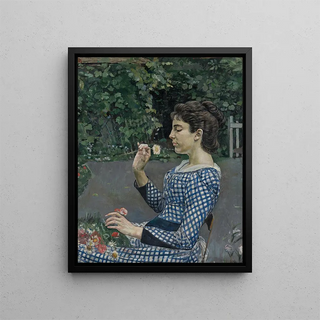Art print | Portrait of Helen Weigl - Ferdinand Hodler


View from behind

Frame (optional)
Portrait of Helen Weigl - Ferdinand Hodler – Captivating Introduction
In the world of art, some works transcend mere frames to become silent witnesses of history and human emotion. The "Portrait of Helen Weigl" by Ferdinand Hodler is a perfect example. This painting, which captures not only the physical appearance of its subject but also a rare psychological depth, evokes an atmosphere filled with mystery and beauty. Through this portrait, Hodler invites us to delve into the intimacy of a woman whose gaze seems to tell a thousand stories. The piece, both delicate and powerful, transports us to a bygone era while remaining resolutely contemporary in its expression.
Style and uniqueness of the work
Ferdinand Hodler's style is characterized by an relentless pursuit of inner truth and a stylized representation of reality. In the "Portrait of Helen Weigl," he uses rich colors and harmonious shapes to create an atmosphere that is both serene and captivating. Helen's face, bathed in soft light, is highlighted by a background that appears to blend into the nuances of her dress. This compositional choice emphasizes the intensity of the model's gaze, which becomes the focal point of the artwork. The flowing lines and delicate contours demonstrate the artist's technical skill, while the color palette, both subtle and vibrant, evokes a sense of calm and contemplation. Far from being a simple portrait, this work is a true exploration of the human soul.
The artist and his influence
Ferdinand Hodler, an emblematic figure of symbolism and modernism, left a mark on the art scene of the late 19th and early 20th centuries. Originating from Switzerland, he developed a unique style, combining a strong influence of Impressionism with a more spiritual and introspective quest. His innovative approach to color and form inspired many contemporary artists and paved the way for new forms of expression. The "Portrait of Helen Weigl" perfectly illustrates this duality between realistic representation and emotional expression. Through this work, Hodler does not merely capture a person's appearance but manages to reveal a

Matte finish

View from behind

Frame (optional)
Portrait of Helen Weigl - Ferdinand Hodler – Captivating Introduction
In the world of art, some works transcend mere frames to become silent witnesses of history and human emotion. The "Portrait of Helen Weigl" by Ferdinand Hodler is a perfect example. This painting, which captures not only the physical appearance of its subject but also a rare psychological depth, evokes an atmosphere filled with mystery and beauty. Through this portrait, Hodler invites us to delve into the intimacy of a woman whose gaze seems to tell a thousand stories. The piece, both delicate and powerful, transports us to a bygone era while remaining resolutely contemporary in its expression.
Style and uniqueness of the work
Ferdinand Hodler's style is characterized by an relentless pursuit of inner truth and a stylized representation of reality. In the "Portrait of Helen Weigl," he uses rich colors and harmonious shapes to create an atmosphere that is both serene and captivating. Helen's face, bathed in soft light, is highlighted by a background that appears to blend into the nuances of her dress. This compositional choice emphasizes the intensity of the model's gaze, which becomes the focal point of the artwork. The flowing lines and delicate contours demonstrate the artist's technical skill, while the color palette, both subtle and vibrant, evokes a sense of calm and contemplation. Far from being a simple portrait, this work is a true exploration of the human soul.
The artist and his influence
Ferdinand Hodler, an emblematic figure of symbolism and modernism, left a mark on the art scene of the late 19th and early 20th centuries. Originating from Switzerland, he developed a unique style, combining a strong influence of Impressionism with a more spiritual and introspective quest. His innovative approach to color and form inspired many contemporary artists and paved the way for new forms of expression. The "Portrait of Helen Weigl" perfectly illustrates this duality between realistic representation and emotional expression. Through this work, Hodler does not merely capture a person's appearance but manages to reveal a






